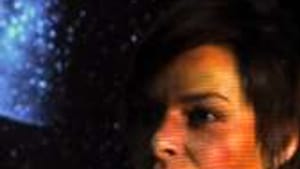Stay in the Loop
BSR publishes on a weekly schedule, with an email newsletter every Wednesday and Thursday morning. There’s no paywall, and subscribing is always free.
Cooking in the DNA kitchen
"Chimera': DNA anomalies at Swarthmore

The first thing that came to mind as Chimera unraveled in its Philadelphia-area premiere at Swarthmore College was this Polish joke:
Weeping, Basia goes to her father to confess: "Tata, I'm pregnant." Tata, alarmed, replies, "Are you sure it's yours?"
By the end of this dizzyingly smart, awfully witty yet ultimately tragic play, that joke isn't so funny any more.
A chimera is a medical phenomenon in which two sets of DNA exist in a single body. With the advent of DNA testing, chimerism is found to be more common than was previously thought. Ultimately this research may produce a better understanding of homosexuality, hermaphroditism and a host of other genetic wonders that until now have been perceived as anomalies.
This New York hit about the subject— conceived, acted, written and produced by three Swarthmore alums— began its road tour at the college during its Arts weekend on April 14 with two shows.
Livable Lounger
The play was co-created by Suli Holum, who performed it, and Deborah Stein, who wrote it, then evolved through their teamwork with costumer Tara Webb, whose 1950s-based Capri-length jumpsuit with its chameleon changeability looks very close to the "Livable Lounger" pattern my mother-in-law, Joanne Sabatini, designed back then. It's so filled with clever surprises that it's almost another character.
The one-act, mono-drama premiered at SoHo's HERE in January to glowing and well-deserved reviews. Holum plays scientist/mother Jennifer Samuels with a deliberately annoying yet strangely engaging Ohio accent, then flips into the role of the spectacled eight-year-old son she has rejected, even before discovering he isn't her own. A mother knows. Even if she is not the mother.
"This is not a tragedy," Jennifer tells us. "No one dies." But death alone does not make a tragedy. Absence and abandonment are good enough on their own, and this play has both. Jennifer decides to walk out on her son once she runs an exhaustive set of tests in her lab that determines they do not share the same DNA. But this only opens another set of inquiries: about human maternal love, animals who leave the runt of the litter behind because it can't survive, and so on.
Kitchen and lab
James Sugg jumped in midway through the process, taking over as sound designer, and kept it as eerie as Webb's Kool-Aid green color theme. Jeremy Wilhelm designed the minimalist, white set that served as kitchen and laboratory and as blank backdrop for Kate Freer's and David Tennent's video designs.
Deborah Stein's text is about as chilling and disarmingly charming as any could be for a play on this subject, but all the other elements— sound, costume, video and Holum's acting— make it one of the most perfectly realized works I've seen in a long time. I saw it twice that day and can't wait to see it again.
Holum, it turns out, is married to Trey Lyford, who with Geoff Sobelle comprise Rainpan 43 (both wicked actors and theater-makers whose most recent hit, Elephant Room, is touring), and has a four-year-old son with Lyford. So a great acting dynasty may already have been conceived, with or without chimeras.
Weeping, Basia goes to her father to confess: "Tata, I'm pregnant." Tata, alarmed, replies, "Are you sure it's yours?"
By the end of this dizzyingly smart, awfully witty yet ultimately tragic play, that joke isn't so funny any more.
A chimera is a medical phenomenon in which two sets of DNA exist in a single body. With the advent of DNA testing, chimerism is found to be more common than was previously thought. Ultimately this research may produce a better understanding of homosexuality, hermaphroditism and a host of other genetic wonders that until now have been perceived as anomalies.
This New York hit about the subject— conceived, acted, written and produced by three Swarthmore alums— began its road tour at the college during its Arts weekend on April 14 with two shows.
Livable Lounger
The play was co-created by Suli Holum, who performed it, and Deborah Stein, who wrote it, then evolved through their teamwork with costumer Tara Webb, whose 1950s-based Capri-length jumpsuit with its chameleon changeability looks very close to the "Livable Lounger" pattern my mother-in-law, Joanne Sabatini, designed back then. It's so filled with clever surprises that it's almost another character.
The one-act, mono-drama premiered at SoHo's HERE in January to glowing and well-deserved reviews. Holum plays scientist/mother Jennifer Samuels with a deliberately annoying yet strangely engaging Ohio accent, then flips into the role of the spectacled eight-year-old son she has rejected, even before discovering he isn't her own. A mother knows. Even if she is not the mother.
"This is not a tragedy," Jennifer tells us. "No one dies." But death alone does not make a tragedy. Absence and abandonment are good enough on their own, and this play has both. Jennifer decides to walk out on her son once she runs an exhaustive set of tests in her lab that determines they do not share the same DNA. But this only opens another set of inquiries: about human maternal love, animals who leave the runt of the litter behind because it can't survive, and so on.
Kitchen and lab
James Sugg jumped in midway through the process, taking over as sound designer, and kept it as eerie as Webb's Kool-Aid green color theme. Jeremy Wilhelm designed the minimalist, white set that served as kitchen and laboratory and as blank backdrop for Kate Freer's and David Tennent's video designs.
Deborah Stein's text is about as chilling and disarmingly charming as any could be for a play on this subject, but all the other elements— sound, costume, video and Holum's acting— make it one of the most perfectly realized works I've seen in a long time. I saw it twice that day and can't wait to see it again.
Holum, it turns out, is married to Trey Lyford, who with Geoff Sobelle comprise Rainpan 43 (both wicked actors and theater-makers whose most recent hit, Elephant Room, is touring), and has a four-year-old son with Lyford. So a great acting dynasty may already have been conceived, with or without chimeras.
What, When, Where
Chimera. By Suli Holum and Deborah Stein. April 14, 2012 at Lang Performing Arts Center, Swarthmore College, Swarthmore, Pa. Swarthmore College. (888) 495-8358 or www.swarthmore.edu.
Sign up for our newsletter
All of the week's new articles, all in one place. Sign up for the free weekly BSR newsletters, and don't miss a conversation.

 Merilyn Jackson
Merilyn Jackson